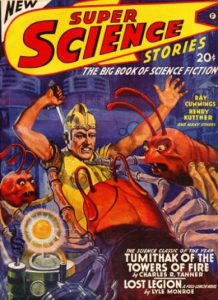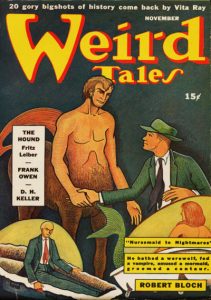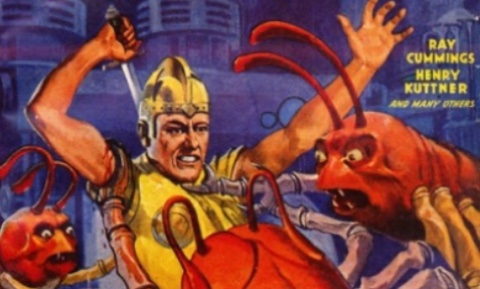 Although he got his start as a writer of fantasy, horror, detective, and science fiction for the pulp magazines, author Ray Bradbury defied categorization. He referred to himself as a “magician of words.”
Although he got his start as a writer of fantasy, horror, detective, and science fiction for the pulp magazines, author Ray Bradbury defied categorization. He referred to himself as a “magician of words.”
Bradbury was born on August 22, 1920, in Waukegan, Illinois and decided to become a writer around the age of twelve. From his earliest memories, he was a voracious reader and consumer of popular genre fiction, silent movies, radio programming, newspaper comic strips, circuses, magicians and more. From his earliest years forward, Ray Douglas Bradbury was enamored with the Buck Rogers newspaper strip and the works of Jules Verne, L. Frank Baum, Edgar Rice Burroughs and others.
After moving with his family to Los Angeles in 1934, the teenaged Bradbury discovered science fiction fandom. Through the Los Angeles Science Fiction Society, he met such people as Forrest J Ackerman, Hannes Bok, Leigh Brackett, Ray Harryhausen, Henry Hasse, Robert A. Heinlein, and Henry Kuttner. It was Kuttner, in particular, who took the young Bradbury under his wing, urging him to read more outside the fields of fantasy and science fiction, critiquing his stories, and simply telling the budding author to simply write and “shut up.”
Collaborating with Henry Hasse, Ray Bradbury sold his first story in 1941. Based on a work originally published in Bradbury’s self-published fanzine, FUTURE FANTASIA, “Pendulum” ran in the November 1941 issue of SUPER SCIENCE STORIES. The issue featured front cover art by Robert C. Sherry. The Bradbury and Hasse team would sell two more collaborations before the younger Bradbury set off on his own.
With the help of writers Henry Kuttner and Leigh Brackett, as well as literary agent Julius Schwartz, Ray Bradbury began to find regular markets for his science fiction and fantasy in AMAZING STORIES, PLANET STORIES, SUPER SCIENCE STORIES, THRILLING WONDER STORIES, and WEIRD TALES. It was largely from the latter that Bradbury would draw the stories for his first book, the legendary DARK CARNIVAL, published by Arkham House in 1947.
In 1944, Ray Bradbury also began to contribute crime and detective fiction to DETECTIVE TALES, DIME MYSTERY MAGAZINE, NEW DETECTIVE MAGAZINE, and other pulps. At the urging of a friend, the young writer also started to submit his work to the more prestigious (and better paying) “slicks.” These included AMERICAN MERCURY, CHARM, COLLIER’S, MADEMOISELLE, and THE NEW YORKER. His story, “The Big Black and White Game,” published in the August 1945 issue of AMERICAN MERCURY, was included in THE BEST AMERICAN SHORT STORIES OF THE YEAR anthology. “The Homecoming,” published in the October 1946 issue of MADEMOISELLE (after being rejected by WEIRD TALES), found its way into the pages of THE O. HENRY PRIZE STORIES OF 1947.
As his fiction began to be read by a wider audience, Bradbury came to the attention of former COLLIER’S editor Don Congdon. About a year after writing Bradbury to express his admiration for the author’s work, Congdon became Ray Bradbury’s literary agent. During the summer of 1949, Bradbury’s representative arranged a meeting with Doubleday editor Walter I. Bradbury (no relation) in New York City. According to Sam Weller’s THE BRADBURY CHRONICLES, it was during this meeting that the Doubleday editor suggested: “What about all those Martian stories you’ve been writing for PLANET STORIES and THRILLING WONDER? Wouldn’t there be a book if you took all those stories and tied them together into a tapestry?”
 Thus was born THE MARTIAN CHRONICLES, published in 1950 by Doubleday and Company. It would be this work — a “fix-up” novel consisting of a mixture of previously published and new, loosely connected stories — that would assure Ray Bradbury’s success as an author.
Thus was born THE MARTIAN CHRONICLES, published in 1950 by Doubleday and Company. It would be this work — a “fix-up” novel consisting of a mixture of previously published and new, loosely connected stories — that would assure Ray Bradbury’s success as an author.
Other books would follow his Mars collection, including THE ILLUSTRATED MAN in 1951, FAHRENHEIT 451 and THE GOLDEN APPLES OF THE SUN in 1953, THE OCTOBER COUNTRY in 1955, DANDELION WINE in 1957, A MEDICINE FOR MELANCHOLY in 1959, R IS FOR ROCKET and SOMETHING WICKED THIS WAY COMES in 1962, THE MACHINERIES OF JOY in 1964, as well as many others. Bradbury would also make significant contributions to ESQUIRE, GALAXY, THE MAGAZINE OF FANTASY AND SCIENCE FICTION, PLAYBOY, THE SATURDAY EVENING POST, and other magazines.
Ray Bradbury won the World Fantasy Award in 1977, the SFWA Grand Master Award in 1989, the Bram Stoker Award for Lifetime Achievement in 1989, an Emmy Award in 1994, the National Medal of Arts in 2004, a special citation from the Pulitzer Prize jury “for his distinguished, prolific, and deeply influential career as an unmatched author of science fiction and fantasy” in 2007, and many other awards. The author died on June 5, 2012, a few months shy of 92.
On Saturday, August 8, PulpFest 2020 welcomes Professor Garyn G. Roberts for “Visions of Bradbury: The Author at 100.” Bradbury’s pal for more than thirty years, Professor Roberts will discuss the Science Fiction Grand Master and “Poet of the Pulps,” beginning at 7:50 PM. Our 2013 Munsey Award winner promises to share many unique items that he collected during his long friendship with Ray Bradbury.
(To learn more about Ray Bradbury, we recommend BECOMING RAY BRADBURY, by Jonathan R. Eller (University of Illinois Press, 2011), NOLAN ON BRADBURY, by William F. Nolan (Hippocampus Press, 2013), and THE BRADBURY CHRONICLES: THE LIFE OF RAY BRADBURY, by Sam Weller (HarperCollins Publishers, 2005).
The November 1942 issue of WEIRD TALES — with cover art by Richard Bennett — features the first Ray Bradbury story to be published by “The Unique Magazine,” “The Candle.” The story’s ending was suggested by Bradbury’s mentor, Henry Kuttner.
Garyn G. Roberts, PH.D., has written extensively about the pulps, both professionally and as a fan. He has edited or co-edited some of the best collections from the pulps including A CENT A STORY: THE BEST FROM TEN DETECTIVE ACES, MORE TALES OF THE DEFECTIVE DETECTIVE IN THE PULPS, THE COMPLEAT ADVENTURES OF THE MOON MAN, THE MAGICAL MYSTERIES OF DON DIAVOLO, and THE COMPLEAT GREAT MERLINI SAGA.
Roberts’s anthology, THE PRENTICE HALL ANTHOLOGY OF SCIENCE FICTION AND FANTASY, a college level textbook, is notable for the attention paid to the pulp magazines. It was honored with the Ray and Pat Browne National Popular Culture Book Award. His comprehensive examination of Chester Gould’s creation, DICK TRACY AND AMERICAN CULTURE, was a Mystery Writers of American Edgar Allan Poe Award finalist.
Garyn regularly contributes research for, edits, and provides introductions for books by Battered Silicon Press Dispatch Box, Haffner Press, Steeger Books, and other publishers. He has published extensively on the life and works of his friends, Ray Bradbury and Robert Bloch, and often serves as a presenter and panelist at conventions.)






